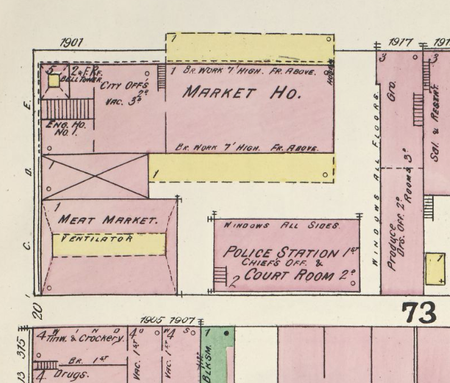Birmingham City Hall (1882): Difference between revisions
(Created page with "The '''Birmingham City Hall''' constructed in 1882 was the first permanent municipal government building in Birmingham. The three-story brick building was completed in...") |
|||
| (3 intermediate revisions by the same user not shown) | |||
| Line 1: | Line 1: | ||
[[File:1891 Bham City Hall map.png|right|thumb|450px|Detail of 1891 Sanborn map showing Birmingham City Hall]] | |||
The '''Birmingham City Hall''' constructed in [[1882]] was the first permanent municipal government building in [[Birmingham]]. The three-story brick building was completed in [[1882]] with funds from the city's municipal bonds, issued under the seal of the [[Elyton Land Company]]. | The '''Birmingham City Hall''' constructed in [[1882]] was the first permanent municipal government building in [[Birmingham]]. The three-story brick building was completed in [[1882]] with funds from the city's municipal bonds, issued under the seal of the [[Elyton Land Company]]. | ||
The building featured arched openings facing [[19th Street North|19th Street]] and [[4th Avenue North]] for | The building featured arched openings facing [[19th Street North|19th Street]] and [[4th Avenue North]] for [[Birmingham Fire Station No. 1]] and for market halls. The roof was punctuated with a tall wooden tower at the corner. The [[Birmingham Police Department]] and [[Birmingham Municipal Court]] occupied a separate structure on the interior of the block. | ||
In [[1884]] the City Hall building appeared in a sensational and fraudulent news item penned by Joe Mulhattan. He described a [[underground river|huge river flowing beneath the city]], which was built on a thin "crust" of stone a few feet thick. He claimed that the City Hall had settled 4 feet on one corner into a widening fissure in the earth. The story was published as fact in the ''Louisville Courier-Journal'' and subsequently picked up by other newspapers. The city was "flooded with telegrams" inquiring about the calamity over the following days. | In [[1884]] the City Hall building appeared in a sensational and fraudulent news item penned by Joe Mulhattan. He described a [[underground river|huge river flowing beneath the city]], which was built on a thin "crust" of stone a few feet thick. He claimed that the City Hall had settled 4 feet on one corner into a widening fissure in the earth. The story was published as fact in the ''Louisville Courier-Journal'' and subsequently picked up by other newspapers. The city was "flooded with telegrams" inquiring about the calamity over the following days. | ||
The structure served for nearly 20 years before Mayors [[Frank Evans]] and [[Mel Drennen]] oversaw construction of a [[Birmingham City Hall (1901)|massive replacement]] on the same site. | The structure served for nearly 20 years before Mayors [[Frank Evans]] and [[Mel Drennen]] oversaw construction of a [[Birmingham City Hall (1901)|massive replacement]] on the same site. | ||
==Tenants== | |||
* [[19th Street North]] | |||
** 317-321: meat market (1891) | |||
** 329: [[Birmingham Fire Station No. 1]] (1897) | |||
* [[4th Avenue North]] | |||
** 1907-1909: market hall, [[Birmingham Police Department]] and [[Birmingham Municipal Court]] at rear (1882-1900), | |||
==References== | ==References== | ||
Latest revision as of 18:04, 14 January 2024
The Birmingham City Hall constructed in 1882 was the first permanent municipal government building in Birmingham. The three-story brick building was completed in 1882 with funds from the city's municipal bonds, issued under the seal of the Elyton Land Company.
The building featured arched openings facing 19th Street and 4th Avenue North for Birmingham Fire Station No. 1 and for market halls. The roof was punctuated with a tall wooden tower at the corner. The Birmingham Police Department and Birmingham Municipal Court occupied a separate structure on the interior of the block.
In 1884 the City Hall building appeared in a sensational and fraudulent news item penned by Joe Mulhattan. He described a huge river flowing beneath the city, which was built on a thin "crust" of stone a few feet thick. He claimed that the City Hall had settled 4 feet on one corner into a widening fissure in the earth. The story was published as fact in the Louisville Courier-Journal and subsequently picked up by other newspapers. The city was "flooded with telegrams" inquiring about the calamity over the following days.
The structure served for nearly 20 years before Mayors Frank Evans and Mel Drennen oversaw construction of a massive replacement on the same site.
Tenants
- 19th Street North
- 317-321: meat market (1891)
- 329: Birmingham Fire Station No. 1 (1897)
- 4th Avenue North
- 1907-1909: market hall, Birmingham Police Department and Birmingham Municipal Court at rear (1882-1900),
References
- White, Marjorie Longenecker (1977) Downtown Birmingham: Architectural and Historical Walking Tour Guide. Birmingham: Birmingham Historical Society.
